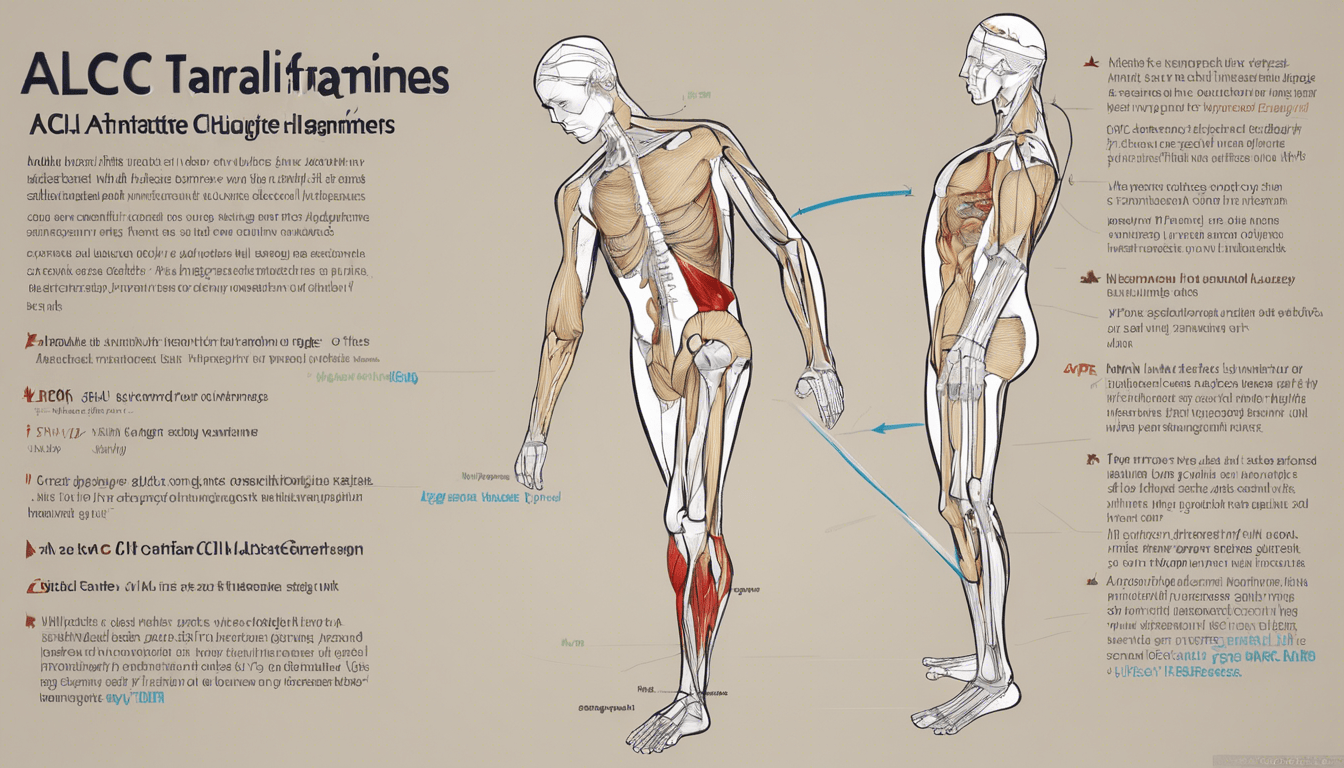Experiencing a sudden twist or turn during physical activity can lead to one of the most common yet dreaded injuries among athletes: an ACL tear. Understanding the early acl tear symptoms can be crucial for prompt treatment and effective recovery. The Anterior Cruciate Ligament (ACL), a critical stabilizer in the knee, is susceptible to tears during high-impact sports and activities. When compromised, it not only limits physical performance but also increases the risk of further injury. Recognizing the symptoms of an ACL tear and seeking immediate consultation can significantly influence the healing process and outcome.
In this article, we delve into the essential aspects of detecting ACL tear symptoms, from the initial signs of injury to the comprehensive diagnosis and treatment options available. We aim to provide an informative guide on acl injury symptoms and acl ligament tear to help individuals identify potential injuries early on. Furthermore, the discussion extends to various acl injury treatments, including the latest techniques in ACL reconstruction. By understanding these facets, we can better prepare for preventative measures and long-term management strategies to ensure optimal knee health and functionality.
What is the Anterior Cruciate Ligament (ACL)?
The Anterior Cruciate Ligament, or ACL, is one of the four critical ligaments that contribute to the stability of the knee joint. It plays a crucial role in connecting the thighbone (femur) to the shinbone (tibia), forming a key part of the knee’s structural integrity.
Function and Importance of the ACL
The ACL is instrumental in stabilizing the knee by limiting excessive forward movement of the tibia in relation to the femur and controlling the knee’s rotational movements. This ligament is essential for activities that involve sudden changes in direction, jumping, or landing, which are common in sports like soccer, basketball, and skiing. The ACL’s ability to prevent the tibia from sliding too far forward and to stabilize the knee during rotational movements is critical for both athletic performance and everyday activities.
Anatomy of the Knee and ACL
Within the knee joint, the ACL and the Posterior Cruciate Ligament (PCL) cross each other, forming an “X” shape. This configuration allows them to work together to stabilize the knee in multiple directions. The ACL is positioned toward the front of the knee, closer to the patella, while the PCL is located towards the back. This arrangement is crucial for the knee’s ability to withstand the stresses of motion and weight-bearing activities.
Common Causes of ACL Tears
ACL injuries typically occur through mechanisms such as sudden pivoting, incorrect landings from jumps, or direct impacts to the knee during sports. Non-contact injuries, such as rapidly changing direction with a planted foot, account for the majority of ACL tears. Contact-related injuries, while less common, often occur due to a direct blow to the knee, such as might be experienced in a football tackle. These injuries can lead to a partial or complete tear of the ligament, depending on the force and angle of impact.
Understanding the structure and function of the ACL, as well as the common causes of injuries to it, is vital for both preventing injuries and effectively treating them when they occur.
Symptoms of an ACL Injury
How to Recognize an ACL Tear
When an ACL injury occurs, a distinct “popping” sound is often the first indication, accompanied by an immediate sensation of instability in the knee. Many individuals report feeling as though their knee has given out from under them. This can occur during activities that involve sudden changes in direction or impact.
Early and Late Symptoms
Initially, the symptoms include severe pain that makes continuing any activity difficult. This is quickly followed by rapid swelling and a significant loss of range of motion in the knee joint. As time progresses, if the ACL injury is not treated, symptoms can evolve into chronic knee instability, with the knee frequently “giving way” during weight-bearing activities.
Differences in Symptoms Among Individuals
The severity of ACL injury symptoms can vary widely among individuals. Some may experience intense pain and swelling immediately after the injury, while others might only feel a mild discomfort or instability without significant swelling. This variation largely depends on the extent of the tear and the individual’s prior level of physical activity.
Diagnosing an ACL Injury
Initial Evaluation by a Physician
When we suspect an ACL injury, the initial step involves a thorough physical examination by a physician. This examination typically includes palpation of the knee to check for swelling, tenderness, or instability, and range of motion tests to evaluate the knee’s flexibility and movement. Ligament stability tests such as the Lachman test or anterior drawer test are crucial to assess the integrity of the ACL.
Tests and Imaging Techniques
To confirm the diagnosis of an ACL injury and rule out other potential injuries, imaging tests are often necessary. X-rays may be used to identify any bone fractures, though they do not show soft tissues like ligaments and tendons. More detailed imaging, such as MRI scans, provides comprehensive images of the soft tissues, including the ACL, to determine the extent of the injury. Ultrasound may also be employed to check for injuries in the ligaments, tendons, and muscles of the knee.
Common Diagnostic Challenges
Diagnosing an ACL injury can be challenging due to several factors. Swelling or pain may mask the true extent of the injury, making it difficult to determine the exact mechanism of injury, especially in cases of gradual onset. The variability in the severity of ACL tears, from partial to complete ruptures, and the presence of other concurrent injuries such as meniscus tears or collateral ligament sprains, can obscure the primary ACL injury.
Treatment Options for ACL Injuries
Nonsurgical Treatments
For some individuals, particularly those who are less active or older, nonsurgical options may be recommended. These treatments focus on alleviating symptoms without surgery and include physical therapy, activity modifications, and the use of braces. Physical therapy aims to strengthen the muscles around the knee, especially the hamstrings, to compensate for the lack of ACL support. Activity modification involves adapting lifestyle and sports activities to reduce knee stress, such as switching to low-impact sports like cycling or swimming.
Bracing is another common nonsurgical approach. While some patients may find stability with the use of a hinged sports brace, others might continue to experience instability episodes despite its use. The decision to opt for nonsurgical methods often depends on the patient’s activity level, age, and the severity of the ACL injury.
Surgical Treatments
Surgical intervention is typically recommended for younger, active individuals or those whose injuries involve other knee structures. ACL reconstruction surgery involves replacing the torn ligament with a graft, usually taken from the patient’s patellar tendon, hamstring tendons, or, less commonly, a donor. This procedure is mostly performed arthroscopically, which minimizes recovery time and maximizes the functional outcome.
Post-surgery, the knee is usually stabilized with a brace, and weight-bearing is gradually increased as tolerated. The choice of graft and specific surgical techniques may vary based on the surgeon’s preference and the patient’s specific conditions.
Rehabilitation and Recovery
Rehabilitation following ACL surgery is crucial and is divided into phases. Initially, the focus is on reducing knee swelling and pain while slowly regaining motion and strength. The use of crutches may be necessary until the patient can bear weight comfortably.
The subsequent phase involves more active physical therapy, including exercises like cycling and light jogging, to restore full knee motion and muscle strength. Eventually, the patient may transition from a postoperative knee brace to a sports brace as they prepare to return to more demanding physical activities.
The final phase of recovery focuses on a gradual return to full activity, ensuring the knee is strong and stable enough to handle the physical demands of the patient’s lifestyle. This phase can last anywhere from four to eight months post-surgery, depending on the individual’s progress and the nature of their activities.
Throughout the recovery process, continuous assessment and adjustments by healthcare professionals ensure optimal outcomes, with the goal of returning to pre-injury levels of activity and preventing future injuries.
Prevention and Long-Term Management
Injury Prevention Strategies
Preventing ACL injuries is crucial, especially in sports that involve high-impact or rapid movement changes. Key strategies include enhancing flexibility and strength, particularly in the core, hips, and legs. We can significantly reduce our risk by learning proper movement patterns such as bending the knees during landings and maintaining alignment to protect the joints. Regularly performing exercises that improve balance and agility also plays a vital role. Effective drills should become second nature, ensuring that movements are performed correctly without conscious effort.
Physical Therapy Recommendations
Physical therapy is essential for both prevention and recovery from ACL injuries. Strengthening exercises for the hamstrings, quadriceps, and core are recommended to support the knee. Exercises like the Romanian deadlift are particularly beneficial for the hamstrings and glutes, enhancing stability around the knee. Additionally, therapists often emphasize the importance of a proper warm-up routine, which should include sport-specific exercises to prepare the muscles and joints for the stress of physical activity.
Long-Term Outcomes and Considerations
Long-term management of ACL health is crucial to prevent re-injury and other complications such as post-traumatic osteoarthritis. Maintaining a strong and flexible muscle system around the knee helps manage long-term stability and function. Programs like the UPMC ACL Injury Prevention Program are designed to assist athletes in returning to sports safely and preventing future injuries. Awareness of the increased risk of arthritis and other long-term issues is vital for managing health decisions and activity levels post-recovery.
Conclusion
Throughout this article, we have explored the complex nature of ACL injuries, from early symptoms and diagnosis techniques to comprehensive treatment and prevention strategies. Emphasizing the critical importance of recognizing the first signs of an ACL tear and seeking prompt medical advice, we underscored how early intervention can significantly influence recovery outcomes. Moreover, the discussion about the various treatment options, including nonsurgical methods and surgical reconstruction, along with the indispensable role of rehabilitation, provided valuable insights for individuals facing this challenging injury.
The broader implications of ACL injury management extend beyond immediate treatment, encompassing long-term prevention and knee health maintenance strategies. By adopting injury prevention techniques, such as enhancing muscle strength and flexibility and learning proper movement patterns, individuals can greatly reduce their risk of ACL injuries. Moreover, the journey through recovery to returning to pre-injury levels of activity underscores the necessity of a patient, disciplined approach to rehabilitation. This insight into the complexities of ACL injuries ultimately empowers readers with the knowledge to proactively manage and prevent these injuries, contributing to their overall well-being and athletic performance.




